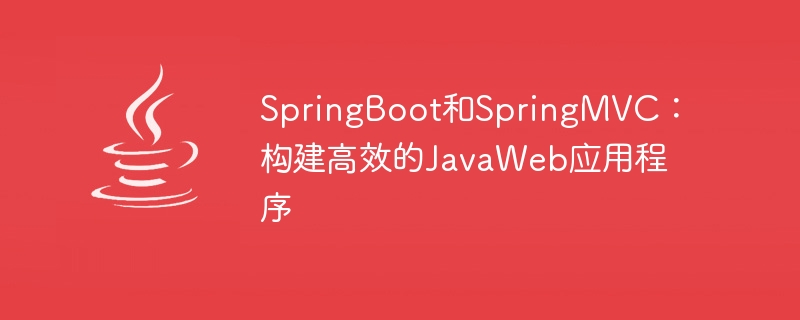

SpringBoot and SpringMVC: Building efficient JavaWeb applications requires specific code examples
Introduction:
In today's Internet era, JavaWeb applications are the developer The most commonly used development method. As two very important frameworks in JavaWeb development, SpringBoot and SpringMVC provide developers with an efficient and simplified development method. This article will introduce the concepts and features of SpringBoot and SpringMVC, and provide some specific code examples to help readers better understand and apply these two frameworks.
1. What is SpringBoot and SpringMVC:
2. Characteristics of SpringBoot and SpringMVC:
3. SpringBoot and SpringMVC code examples:
<dependency>
<groupId>org.springframework.boot</groupId>
<artifactId>spring-boot-starter-web</artifactId>
</dependency>(2) Write a simple Controller:
@RestController
public class HelloController {
@GetMapping("/hello")
public String hello() {
return "Hello, SpringBoot!";
}
} (3) Start the application:
Write an entry class and add @SpringBootApplication Notes:
@SpringBootApplication
public class Application {
public static void main(String[] args){
SpringApplication.run(Application.class, args);
}
} (4) Access interface:
After starting the application, access http://localhost:8080/hello## in the browser #, you will see the returned string Hello, SpringBoot!.
<dependency>
<groupId>org.springframework.boot</groupId>
<artifactId>spring-boot-starter-web</artifactId>
</dependency>
@Controller
public class HelloController {
@GetMapping("/hello")
public String hello(Model model) {
model.addAttribute("message", "Hello, SpringMVC!");
return "hello";
}
}src/main/webapp/WEB-INF/views/hello.jsp:
<%@ page language="java" contentType="text/html; charset=UTF-8" pageEncoding="UTF-8"%>
<!DOCTYPE html>
<html>
<head>
<title>Hello</title>
</head>
<body>
<h1>${message}</h1>
</body>
</html>Add the following configuration in
src/main/resources/application.properties:
spring.mvc.view.prefix=/WEB-INF/views/ spring.mvc.view.suffix=.jsp
Write an entry class and add
@SpringBootApplication Notes:
@SpringBootApplication
public class Application {
public static void main(String[] args){
SpringApplication.run(Application.class, args);
}
}After starting the application, visit
http://localhost:8080/hello in the browser , you will see the string Hello, SpringMVC! displayed on the page.
Through the introduction and code examples of this article, we have learned about the concepts and characteristics of SpringBoot and SpringMVC, and how to use them to build efficient JavaWeb applications. The simplified configuration, embedded server, flexible URL mapping and other features of SpringBoot and SpringMVC make it easier for us to develop and deploy web applications. I hope this article can be helpful to readers in their practice of JavaWeb development.
The above is the detailed content of Use SpringBoot and SpringMVC to build an efficient JavaWeb application system. For more information, please follow other related articles on the PHP Chinese website!




